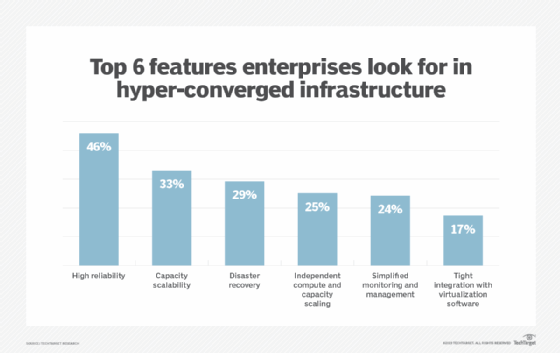
Jakub Jirsk - Fotolia
How do I measure overall TCO when comparing HCI vendors?
Comparing the TCO of deploying different HCI vendors' platforms makes it likelier you'll pick the right one for your organization. Start the process with our checklist.
Every IT purchase carries with it a requirement for some kind of ROI. There are two components that determine ROI: The first is the revenue the investment enables; the second is the total cost of that investment. For everything IT buys, hyper-converged infrastructure included, the TCO is the metric used to calculate exactly how much a new service costs an organization.
TCO hard vs. soft costs
Different organizations calculate TCO differently. For example, some include only hard costs in their TCO calculations and not soft costs. Hard costs include the actual purchase expenses associated with the solution. Soft costs include all the labor costs and other human elements associated with implementation.
Why do some companies not include soft costs in their TCO calculations? Basically, they view employees -- the human element -- as a sunk cost that they have to pay for, so they don't really add more to a solution's actual cost.
Let's take a look at the elements that go into calculating TCO for a hyper-converged infrastructure (HCI) environment.
Checklist: Elements for calculating HCI vendors' TCO
Your initial checklist for assessing hyper-converged products' TCO should include the following:
- The purchase price. This is the amount of the check you wrote to the vendor to procure the solution.
- Implementation costs. This is the amount spent either on salaries or services to implement the new HCI platform.
- Additional software costs. If your HCI product requires additional software, such as procurement of separate hypervisor licenses, you must include these in your TCO.
- Data center space. This is the cost of the space in the data center consumed by the nodes in your new hyper-converged cluster. Often, this total space may be less than what's consumed by your legacy environment.
- Power and cooling. This is the amount of electricity and cooling your solution requires. One of the benefits of hyper-convergence that HCI vendors often tout is the ability to run less equipment, which reduces power and cooling costs.
- Ongoing management costs. This is the amount of salary and benefits associated with the staff managing the HCI environment on an ongoing basis. HCI is often less work to manage than legacy environments, so this can lower TCO.

More elements for calculating HCI TCO
As you're considering different HCI vendors, all of the above points are important. There are some distinctive elements to remember, too. These include the following:
- Hypervisor. Some hyper-converged products from HCI vendors don't require you to buy a separate hypervisor; they're bundled into the platform. These include Nutanix, Scale Computing and Cloudistics.
- Overall performance. This element is workload-dependent. If you have workloads that are demanding on the performance front, a better-performing HCI platform may require less hardware. For example, Pivot3 provides a full NVMe data path that may help you avoid buying as much hardware as would be needed for other HCI products.
- Data protection. Not every hyper-converged product includes data backup by default. Offerings such as Hewlett Packard Enterprise SimpliVity do, however. You might be able to avoid these costs with an HCI that includes this capability.
- Discrete resource scaling. Not all hyper-converged products have to scale linearly. With some, you can scale compute and storage individually, which can help prevent some hardware overhead waste. Two HCI vendors that fit this mold are NetApp and Datrium.

Before purchasing an HCI, it is important to compare products from different HCI vendors. One aspect of this comparison should be calculating the estimated TCO -- including hard and, when warranted and desired, soft costs -- each one will bring to your particular environment. The elements highlighted in this article are a good place to start to get your HCI TCO calculator ball rolling.






